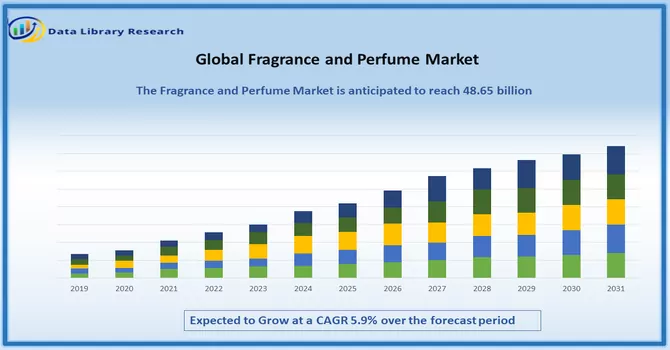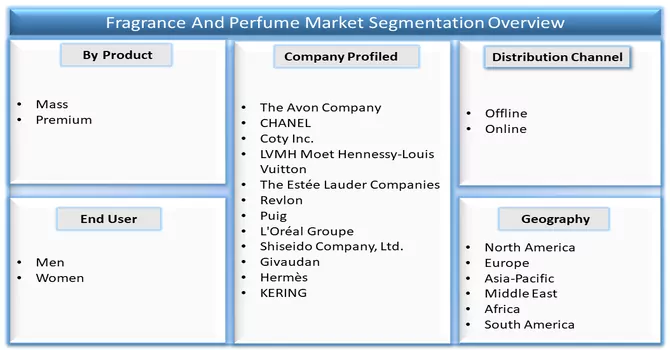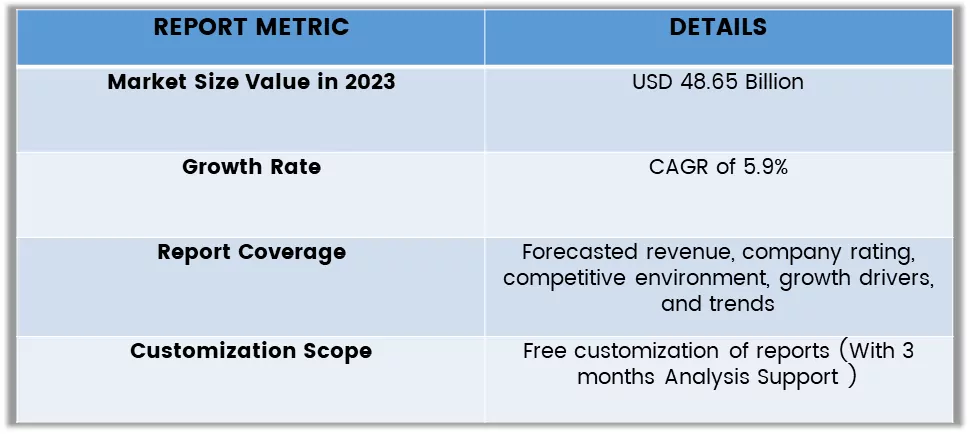The Global Fragrance and Perfume Industry Market is currently valued at USD 48.65 billion in 2023 at a CAGR of over 5.9% over the forecast period, 2024-2031.

Get Complete Analysis Of The Report - Download Free Sample PDF
The fragrance and perfumes industry encapsulates a dynamic and ever-evolving market that caters to the olfactory preferences of consumers worldwide. Focused on creating captivating scents that evoke emotions and enhance personal grooming routines, this industry spans a diverse range of products, including perfumes, colognes, body mists, and scented personal care items. Key players in the market continually innovate to offer a wide array of fragrance options, ranging from floral and fruity to woody and oriental, catering to diverse consumer tastes.
The industry is shaped by changing consumer lifestyles, fashion trends, and a growing awareness of personal grooming, with an increasing emphasis on natural and sustainable ingredients. As the global demand for unique and personalized fragrances rises, the fragrance and perfumes industry remains a vibrant and competitive space, blending artistry with commerce to craft sensory experiences for individuals worldwide.The growth of the fragrance and perfumes industry is propelled by a combination of factors, with the evolving consumer preferences and an increasing focus on personal grooming being primary drivers. As consumers seek to express their individuality through scents, the industry is witnessing a demand for a diverse range of fragrances that cater to various lifestyles and occasions. The rise in disposable income, particularly in emerging markets, has also contributed to the industry's growth, as consumers are more willing to invest in premium and niche fragrances. Additionally, the industry's adaptation to eco-friendly and sustainable practices, incorporating natural ingredients and ethical sourcing, aligns with the growing consumer awareness towards environmentally conscious choices. The continuous innovation in fragrance formulations and packaging, coupled with strategic marketing campaigns, further fuels the expansion of the fragrance and perfumes market on a global scale.
Market Segmentation:
The Fragrance & Perfume Industry is Evolving, Driven by Fashion Trends and the Creation of Innovative Scents. Lighter Aroma Products, Body Sprays, Mists, and Cologne Sprays are Gaining Popularity, Especially Among the Younger Generation. Companies Compete Based On Product Range, Pricing, Ingredients, and Promotional Activities, With Increased Advertising Spend and Online Marketing Strategies. The Industry Anticipates Growth in Sales of Artisanal and Custom-Made Fragrances, With the Asia-Pacific Region Emerging As A Rapidly Expanding Market for Travel-Sized Colognes and Pocket Deodorants. Perfume Market Size, Share & Trends Analysis Report Product (Mass, and Premium), End-user (Men, and Women), Distribution Channel (Offline, and Online), and Geography (North America, Europe, Asia-Pacific, South America, and Middle-East and Africa). The reports offers market size and values in (USD Million) during the forecasted years for the above segments.

For Detailed Market Segmentation - Download Free Sample PDF
Market trends in the fragrance and perfumes industry reflect a nuanced blend of consumer preferences, sustainability, and innovation. Personalization emerges as a key trend, with consumers seeking bespoke and unique scents that resonate with their individuality. Niche and artisanal fragrances gain popularity, driven by a desire for exclusivity and distinctive olfactory experiences. The industry is experiencing a notable shift towards eco-friendly practices, with a growing emphasis on sustainable sourcing, cruelty-free formulations, and recyclable packaging. Transparency in ingredient disclosure is gaining importance as consumers become more discerning about the composition of their chosen scents. Digitalization is influencing the industry, with virtual try-on experiences and online fragrance subscriptions gaining traction. Additionally, gender-neutral and unisex fragrances are breaking traditional norms, reflecting a more inclusive approach to scent choices. As the industry navigates these trends, it continues to evolve, offering a diverse array of fragrances that resonate with the values and preferences of contemporary consumers.
Market Drivers:
The trend toward personalized scents reflects a growing desire among consumers for unique and individualized fragrance experiences
The trend toward personalized scents is indicative of a significant shift in consumer preferences, highlighting a growing desire for unique and individualized fragrance experiences. Consumers are increasingly seeking scents that resonate with their distinct personalities, allowing them to express their individuality through olfactory choices. This trend has spurred the rise of bespoke and custom fragrance offerings, where individuals can tailor scents to their specific preferences, creating a more intimate and personalized connection with the products they choose. The fragrance industry's response to this demand underscores the importance of catering to diverse tastes and embracing the concept of fragrance as a personal statement. As this trend continues to gain momentum, it not only transforms the way consumers engage with fragrances but also influences the innovative landscape of the entire industry.
The emphasis on sustainability serves as a key driver, with consumers becoming more conscious of the environmental impact of their choices
The emphasis on sustainability stands out as a pivotal driver in the fragrance and perfumes industry, driven by a heightened awareness among consumers regarding the environmental impact of their choices. In response to this growing eco-consciousness, fragrance manufacturers are increasingly adopting sustainable practices throughout their production processes. This includes the use of responsibly sourced and natural ingredients, cruelty-free formulations, and eco-friendly packaging solutions. Consumers, now more than ever, seek fragrances that align with their values of environmental stewardship, prompting the industry to innovate and prioritize sustainability as a core principle. This shift not only caters to consumer preferences but also positions fragrance brands as responsible contributors to a more sustainable and environmentally friendly future. As sustainability continues to be a driving force, it reshapes the dynamics of the fragrance industry and fosters a commitment to a greener and more ethical approach to scent creation.
Market Restraints:
Market restraints in the fragrance and perfumes industry encompass various challenges, including the high cost of raw materials, complex regulatory frameworks, and the increasing competition from counterfeit products. Firstly, the sourcing of high-quality and rare natural ingredients often comes with a substantial price tag, impacting production costs and, consequently, retail prices. This can limit the accessibility of premium fragrances to a broader consumer base.Secondly, stringent regulatory requirements and testing procedures pose challenges for fragrance manufacturers, particularly in adhering to evolving safety and environmental standards. Compliance with these regulations can result in prolonged product development timelines and increased expenses.Moreover, the prevalence of counterfeit or imitation fragrances poses a threat to the industry, leading to revenue losses and potential damage to brand reputation. The availability of counterfeit products, often sold at lower prices, undermines the market for authentic fragrances.Additionally, the subjective nature of scent preferences and the difficulty of conveying fragrance nuances through online channels create challenges in marketing and selling products, especially in the growing e-commerce segment.Addressing these restraints requires industry players to navigate a complex landscape, balancing cost considerations, regulatory compliance, and brand protection to sustain growth and innovation in the fragrance and perfumes market.
The fragrance and perfumes industry witnessed a significant impact from the COVID-19 pandemic, marked by shifts in consumer behavior, disrupted supply chains, and changes in retail dynamics. With lockdowns and social distancing measures in place, there was a notable decline in demand for non-essential luxury goods, including fragrances, as consumer priorities shifted towards essential items. The closure of physical retail outlets, a traditional stronghold for fragrance sales, further exacerbated the industry's challenges.Supply chain disruptions, especially in the procurement of natural ingredients and packaging materials, led to production delays and increased costs. The closure of international borders also affected the global trade of fragrant raw materials. The industry faced logistical complexities in transporting products, impacting both domestic and international distribution channels.However, amid the challenges, the industry showcased resilience by adapting to the evolving consumer landscape. E-commerce platforms experienced a surge in fragrance sales as consumers turned to online channels for their purchasing needs. Brands explored digital marketing strategies, virtual try-on experiences, and innovative ways to engage with consumers in the absence of in-store experiences.The pandemic underscored the industry's need for agility and a diversified approach to sales channels. Fragrance companies that embraced digital transformations and demonstrated adaptability emerged more robustly, signaling a potential paradigm shift in the industry's retail dynamics. As the global economy recovers, the fragrance and perfumes industry continues to navigate the lingering effects of the pandemic, balancing the evolving preferences of consumers and the lessons learned during unprecedented times.
Segmental Analysis:
Mass Perfume Segment is Expected to Witness Significant Growth Over the Forecast Period
Mass perfumes offer several advantages in the fragrance market. These perfumes are typically more affordable than luxury or niche fragrances, making them accessible to a broader consumer base. The lower price point also encourages more frequent purchases, driving volume sales. Additionally, mass perfumes often have familiar and appealing scents that cater to popular tastes, making them a safe choice for everyday wear. Their wide availability in supermarkets, drugstores, and online platforms further enhances accessibility, increasing their appeal to consumers. Overall, mass perfumes provide an affordable and convenient way for consumers to enjoy a variety of fragrances for different occasions.
Women Segment is Expected to Witness Significant Growth Over the Forecast Period
The use of perfumes by women is growing across various aspects of their lives. Beyond the traditional use of perfumes for personal fragrance, women are increasingly incorporating perfumes into their daily routines for various purposes. Perfumes are now being used as a form of self-expression, with women selecting fragrances that reflect their personalities and moods. Additionally, perfumes are being used to enhance confidence and boost mood, with certain scents believed to have aromatherapeutic properties that promote well-being. In the workplace, perfumes are used to make a professional impression and create a pleasant environment. Furthermore, perfumes are now being used in social settings to leave a lasting impression and enhance social interactions. Overall, the growing uses of perfumes by women highlight their versatility and the important role they play in enhancing various aspects of women's lives.
Offline Segment is Expected to Witness Significant Growth Over the Forecast Period
Offline distribution channels for perfumes play a critical role in reaching consumers who prefer to experience fragrances in person before making a purchase. These channels include brick-and-mortar stores such as department stores, specialty perfume shops, beauty boutiques, and pharmacies. Department stores often have dedicated fragrance sections where customers can sample a wide range of perfumes and receive personalized assistance from trained staff. Specialty perfume shops and boutiques offer a curated selection of niche and designer fragrances, providing a unique shopping experience for fragrance enthusiasts. Pharmacies and drugstores also carry a variety of popular perfume brands, offering convenience for customers looking to purchase perfumes along with other personal care products. Additionally, perfumes are sold through direct selling channels such as home parties and door-to-door sales, allowing for a more personalized shopping experience. Overall, offline distribution channels play a vital role in the perfume industry, offering consumers the opportunity to explore and purchase fragrances in a physical retail environment.
Europe Region Segment is Expected to Witness Significant Growth Over the Forecast Period
Europe is expected emerged as the dominant region in the perfume industry, as the growth was primarily driven by key markets including Germany, France, and the U.K. In Germany, Coty Inc. secured the top position in 2020, bolstered by robust sales of premium fragrances under brands like Jil Sander and Calvin Klein, alongside successful new product launches from other labels such as Hugo Boss. France, renowned for its prestigious fragrance houses like Christian Dior, Chanel, and Guerlain, has significantly influenced the European market, boasting the highest production and export figures. Looking ahead, Asia Pacific is poised to emerge as the fastest-growing region in the perfume sector, indicating promising prospects for the industry's future expansion.

Get Complete Analysis Of The Report - Download Free Sample PDF
The analyzed market exhibits a high degree of fragmentation, primarily attributable to the presence of numerous players operating on both a global and regional scale. The competitive landscape is characterized by a diverse array of companies, each contributing to the overall market dynamics. This fragmentation arises from the existence of specialized solution providers, established industry players, and emerging entrants, all vying for market share. The diversity in market participants is underscored by the adoption of various strategies aimed at expanding the company presence. On a global scale, companies within the studied market are strategically positioning themselves through aggressive expansion initiatives. This often involves entering new geographical regions, targeting untapped markets, and establishing a robust global footprint. The pursuit of global expansion is driven by the recognition of diverse market opportunities and the desire to capitalize on emerging trends and demands across different regions. Simultaneously, at the regional level, companies are tailoring their approaches to align with local market dynamics. Regional players are leveraging their understanding of specific market nuances, regulatory environments, and consumer preferences to gain a competitive edge. This regional focus allows companies to cater to the unique needs of local clientele, fostering stronger market penetration. To navigate the complexities of the fragmented market, companies are implementing a range of strategies. These strategies include investments in research and development to stay at the forefront of technological advancements, mergers and acquisitions to consolidate market share, strategic partnerships for synergies, and innovation to differentiate products and services. The adoption of such multifaceted strategies reflects the competitive nature of the market, with participants continually seeking avenues for growth and sustainability. In essence, the high fragmentation in the studied market not only signifies the diversity of players but also underscores the dynamism and competitiveness that drive ongoing strategic maneuvers. As companies explore various avenues for expansion, the market continues to evolve, presenting both challenges and opportunities for industry stakeholders.
Some of the prominent players in the global perfume market include:
Recent Development:
1) In April 2023, Coty Inc. unveiled its latest fragrance, the Gucci Eau de Parfum, Where My Heart Beats, highlighting a significant sustainability initiative. The company proudly asserts that the fragrance is crafted using 100% carbon-captured alcohol, aligning with environmental conservation goals. This eco-conscious product is featured as part of Gucci's Alchemist's Garden range, reflecting a commitment to blending luxury with sustainability.
2) In November 2022, Coty Inc. introduced the Chloé Rose Naturelle Intense, marking the fragrance industry's first-ever refillable perfume. This innovative approach not only offers consumers a unique and enduring olfactory experience but also contributes to environmental stewardship. The refillable bottles are designed with a focus on reducing environmental impacts throughout the Product Life Cycle Assessment indicators. Coty's strategic move towards sustainability in fragrance packaging reflects a progressive shift in the industry, where eco-friendly practices are gaining prominence alongside the pursuit of olfactory excellence.
Q1. What is the current Fragrance and Perfume Market size?
As per Data Library Research the Fragrance and Perfume Industry Market is currently valued at USD 48.65 billion in 2023.
Q2. At what CAGR is the market projected to grow within the forecast period?
Fragrance and Perfume Market is expected to grow at a CAGR of over 5.9% over the forecast period.
Q3. Which region has the largest share of the Fragrance and Perfume Market? What are the largest region's market size and growth rate?
Europe has the largest share of the market. For detailed insights on the largest region's market size and growth rate request a sample here.
Q4. Who are the key players in Fragrance and Perfume Market?
Some key players operating in the market include
Data Library Research are conducted by industry experts who offer insight on industry structure, market segmentations technology assessment and competitive landscape (CL), and penetration, as well as on emerging trends. Their analysis is based on primary interviews (~ 80%) and secondary research (~ 20%) as well as years of professional expertise in their respective industries. Adding to this, by analysing historical trends and current market positions, our analysts predict where the market will be headed for the next five years. Furthermore, the varying trends of segment & categories geographically presented are also studied and the estimated based on the primary & secondary research.
In this particular report from the supply side Data Library Research has conducted primary surveys (interviews) with the key level executives (VP, CEO’s, Marketing Director, Business Development Manager and SOFT) of the companies that active & prominent as well as the midsized organization
FIGURE 1: DLR RESEARH PROCESS

Extensive primary research was conducted to gain a deeper insight of the market and industry performance. The analysis is based on both primary and secondary research as well as years of professional expertise in the respective industries.
In addition to analysing current and historical trends, our analysts predict where the market is headed over the next five years.
It varies by segment for these categories geographically presented in the list of market tables. Speaking about this particular report we have conducted primary surveys (interviews) with the key level executives (VP, CEO’s, Marketing Director, Business Development Manager and many more) of the major players active in the market.
Secondary ResearchSecondary research was mainly used to collect and identify information useful for the extensive, technical, market-oriented, and Friend’s study of the Global Extra Neutral Alcohol. It was also used to obtain key information about major players, market classification and segmentation according to the industry trends, geographical markets, and developments related to the market and technology perspectives. For this study, analysts have gathered information from various credible sources, such as annual reports, sec filings, journals, white papers, SOFT presentations, and company web sites.
Market Size EstimationBoth, top-down and bottom-up approaches were used to estimate and validate the size of the Global market and to estimate the size of various other dependent submarkets in the overall Extra Neutral Alcohol. The key players in the market were identified through secondary research and their market contributions in the respective geographies were determined through primary and secondary research.
Forecast Model
